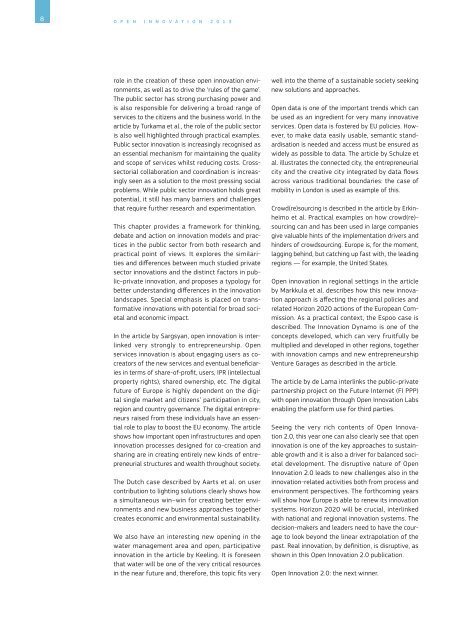Open Innovation 2.0 Yearbook 2013 - European Commission - Europa
Open Innovation 2.0 Yearbook 2013 - European Commission - Europa
Open Innovation 2.0 Yearbook 2013 - European Commission - Europa
You also want an ePaper? Increase the reach of your titles
YUMPU automatically turns print PDFs into web optimized ePapers that Google loves.
8 O P E N I N N O V A T I O N 2 0 1 3<br />
role in the creation of these open innovation environments,<br />
as well as to drive the ‘rules of the game’.<br />
The public sector has strong purchasing power and<br />
is also responsible for delivering a broad range of<br />
services to the citizens and the business world. In the<br />
article by Turkama et al., the role of the public sector<br />
is also well highlighted through practical examples.<br />
Public sector innovation is increasingly recognised as<br />
an essential mechanism for maintaining the quality<br />
and scope of services whilst reducing costs. Crosssectorial<br />
collaboration and coordination is increasingly<br />
seen as a solution to the most pressing social<br />
problems. While public sector innovation holds great<br />
potential, it still has many barriers and challenges<br />
that require further research and experimentation.<br />
This chapter provides a framework for thinking,<br />
debate and action on innovation models and practices<br />
in the public sector from both research and<br />
practical point of views. It explores the similarities<br />
and differences between much studied private<br />
sector innovations and the distinct factors in public–private<br />
innovation, and proposes a typology for<br />
better understanding differences in the innovation<br />
landscapes. Special emphasis is placed on transformative<br />
innovations with potential for broad societal<br />
and economic impact.<br />
In the article by Sargsyan, open innovation is interlinked<br />
very strongly to entrepreneurship. <strong>Open</strong><br />
services innovation is about engaging users as cocreators<br />
of the new services and eventual beneficiaries<br />
in terms of share-of-profit, users, IPR (intellectual<br />
property rights), shared ownership, etc. The digital<br />
future of Europe is highly dependent on the digital<br />
single market and citizens’ participation in city,<br />
region and country governance. The digital entrepreneurs<br />
raised from these individuals have an essential<br />
role to play to boost the EU economy. The article<br />
shows how important open infrastructures and open<br />
innovation processes designed for co-creation and<br />
sharing are in creating entirely new kinds of entrepreneurial<br />
structures and wealth throughout society.<br />
The Dutch case described by Aarts et al. on user<br />
contribution to lighting solutions clearly shows how<br />
a simultaneous win–win for creating better environments<br />
and new business approaches together<br />
creates economic and environmental sustainability.<br />
We also have an interesting new opening in the<br />
water management area and open, participative<br />
innovation in the article by Keeling. It is foreseen<br />
that water will be one of the very critical resources<br />
in the near future and, therefore, this topic fits very<br />
well into the theme of a sustainable society seeking<br />
new solutions and approaches.<br />
<strong>Open</strong> data is one of the important trends which can<br />
be used as an ingredient for very many innovative<br />
services. <strong>Open</strong> data is fostered by EU policies. However,<br />
to make data easily usable, semantic standardisation<br />
is needed and access must be ensured as<br />
widely as possible to data. The article by Schulze et<br />
al. illustrates the connected city, the entrepreneurial<br />
city and the creative city integrated by data flows<br />
across various traditional boundaries: the case of<br />
mobility in London is used as example of this.<br />
Crowd(re)sourcing is described in the article by Erkinheimo<br />
et al. Practical examples on how crowd(re)sourcing<br />
can and has been used in large companies<br />
give valuable hints of the implementation drivers and<br />
hinders of crowdsourcing. Europe is, for the moment,<br />
lagging behind, but catching up fast with, the leading<br />
regions — for example, the United States.<br />
<strong>Open</strong> innovation in regional settings in the article<br />
by Markkula et al. describes how this new innovation<br />
approach is affecting the regional policies and<br />
related Horizon 2020 actions of the <strong>European</strong> <strong>Commission</strong>.<br />
As a practical context, the Espoo case is<br />
described. The <strong>Innovation</strong> Dynamo is one of the<br />
concepts developed, which can very fruitfully be<br />
multiplied and developed in other regions, together<br />
with innovation camps and new entrepreneurship<br />
Venture Garages as described in the article.<br />
The article by de Lama interlinks the public–private<br />
partnership project on the Future Internet (FI PPP)<br />
with open innovation through <strong>Open</strong> <strong>Innovation</strong> Labs<br />
enabling the platform use for third parties.<br />
Seeing the very rich contents of <strong>Open</strong> <strong>Innovation</strong><br />
<strong>2.0</strong>, this year one can also clearly see that open<br />
innovation is one of the key approaches to sustainable<br />
growth and it is also a driver for balanced societal<br />
development. The disruptive nature of <strong>Open</strong><br />
<strong>Innovation</strong> <strong>2.0</strong> leads to new challenges also in the<br />
innovation-related activities both from process and<br />
environment perspectives. The forthcoming years<br />
will show how Europe is able to renew its innovation<br />
systems. Horizon 2020 will be crucial, interlinked<br />
with national and regional innovation systems. The<br />
decision-makers and leaders need to have the courage<br />
to look beyond the linear extrapolation of the<br />
past. Real innovation, by definition, is disruptive, as<br />
shown in this <strong>Open</strong> <strong>Innovation</strong> <strong>2.0</strong> publication.<br />
<strong>Open</strong> <strong>Innovation</strong> <strong>2.0</strong>: the next winner.
















